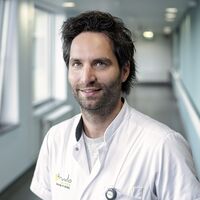Knee injuries (orthopaedics)
Anatomie
Het kniegewricht bestaat uit het dijbeen, scheenbeen en de knieschijf. De uiteinden van de botten zijn bedekt met kraakbeen dat zorgt voor soepele beweging en schokdemping. Het kapsel van de knie is bekleed met slijmvlies om de beweging van de knie soepel te laten verlopen. Aan de voorzijde van de knie bevindt zich de knieschijf die zorgt voor krachtverdeling bij het buigen en strekken van de knie. Tussen de botuiteinden bevinden zich de binnen- en buitenmeniscus die zorgen voor schokabsorptie en stabiliteit. De kniebanden geven stabiliteit: de kruisbanden in het midden zorgen voor draaistabiliteit, de zijbanden geven zijdelingse stevigheid.
Diagnose
De orthopedische chirurg stelt een diagnose door middel van een grondig onderzoek met indien nodig beeldvorming (radiologie). Je kan bij onze specialisten terecht voor erg uiteenlopende knieklachten. Bij mensen die kniepijn krijgen tijdens het sporten, 's nachts wakker worden van de pijn of startproblemen hebben, is dit vaak het gevolg van slijtage van de knie. Bij pijn na een rotatiebeweging, doorzakken van de knie of blokkadeklachten is er meestal een acuut probleem.
Veelvoorkomende problemen aan de knie
Knieartrose
Meniscusletsel
Voorste kruisbandletsel
Veelvoorkomende ingrepen
Orthopaedic surgeons specializing in knee injuries
Meer weten over je revalidatie?
Via onderstaande link vind je meer informatie over het revalidatietraject na een orthopedische aandoening.
Departments
For more information, please visit the orthopaedics department.


